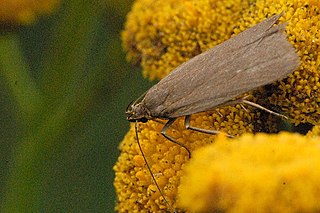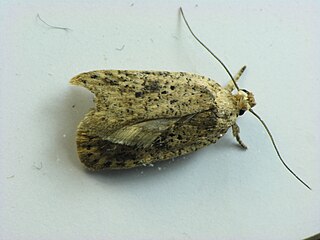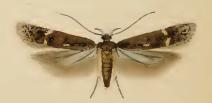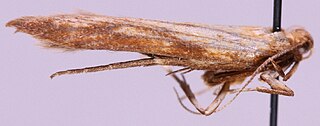
The Gelechiidae are a family of moths commonly referred to as twirler moths or gelechiid moths. They are the namesake family of the huge and little-studied superfamily Gelechioidea, and the family's taxonomy has been subject to considerable dispute. These are generally very small moths with narrow, fringed wings. The larvae of most species feed internally on various parts of their host plants, sometimes causing galls. Douglas-fir (Pseudotsuga) is a host plant common to many species of the family, particularly of the genus Chionodes, which as a result is more diverse in North America than usual for Gelechioidea.

Chrysoesthia drurella is a moth from the family Gelechiidae. In is found in most of Europe, Russia and North America.
Monochroa is a genus of moths in the family Gelechiidae.

Pseudotelphusa scalella is a moth of the family Gelechiidae. It is found from most of Europe to the southern Ural and the Volga region. It is also found in Turkey.

Scrobipalpa acuminatella is a moth of the family Gelechiidae. It is found in most of Europe, as well as Turkey, southern Siberia, Central Asia and China (Anhui). It was recently reported from Canada, with records from Ontario and Québec.

Caryocolum blandella is a moth of the family Gelechiidae. It is found from central and northern Europe to the Ural Mountains and southern Siberia.

Recurvaria leucatella is a moth of the family Gelechiidae. It is found in most of Europe, Turkey, Central Asia and the Caucasus.

Bryotropha terrella is a moth of the family Gelechiidae. It is the type species of the genus Bryotropha. It is found in Europe.

Depressariidae is a family of moths. It has formerly been treated as a subfamily of Gelechiidae, but is now recognised as a separate family, comprising about 2300 species worldwide.

Isophrictis striatella is a moth of the family Gelechiidae. It is found in most of Europe, as well as Turkey and North America.

Bryotropha affinis is a moth of the family Gelechiidae. It is found in most of Europe.

Dichomeridinae is a subfamily of moths in the family Gelechiidae.

Carpatolechia alburnella, the suffused groundling, is a moth of the family Gelechiidae. It is found from most of Europe to Siberia. The habitat consists of woodland and heathland.

Chionodes distinctella, the eastern groundling, is a moth of the family Gelechiidae. It is found in almost all of Europe, as well as most of Russia, Kazakhstan, Central Asia and North Africa. The habitat consists of dry, rocky heath and meadows and the verges and rough pastures.

Chionodes fumatella, the downland groundling, is a moth of the family Gelechiidae. It is found in almost all of Europe. Outside of Europe, it is found in Turkey, the Caucasus, Mongolia and from Siberia to the Russian Far East.

Metzneria neuropterella, the brown-veined neb, is a moth of the family Gelechiidae. It is found from most of Europe to the southern Ural Mountains, the Caucasus, southern and south-eastern Siberia and Mongolia, as well as in North Africa. The habitat consist of short-turfed, herb rich chalk downland.

Metzneria lappella, the burdock seedhead moth or burdock seed moth, is a moth of the family Gelechiidae.

Psoricoptera gibbosella, the humped crest, is a moth of the family Gelechiidae. It is widely distributed in Europe. Outside of Europe, it is found in Turkey, North Africa, China, Japan, Korea, Siberia and the Russian Far East. The habitat consists of mature woodlands.
Ronald William Hodges, known as Ron, was an American entomologist and lepidopterist.















